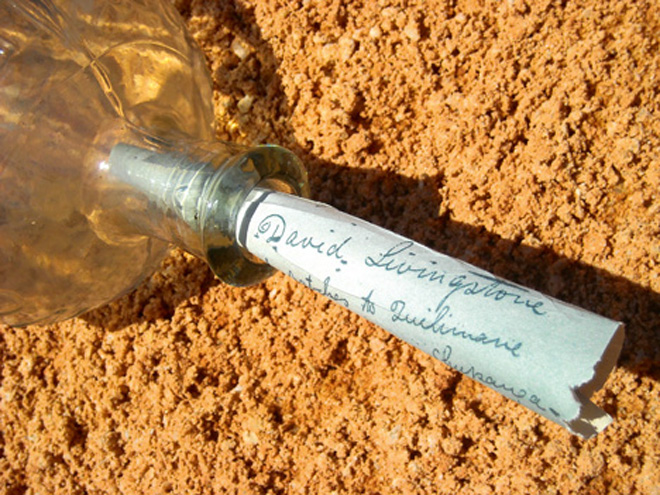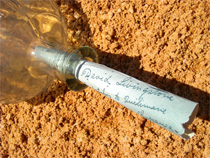Text and photographs: Frikkie Kraamwinkel.
On 25 May 1859, David Livingston stood on the seashore at the Kongone mouth of the Zambezi River, with all his hopes pinned on a letter in an empty bottle.
The famous Scottish explorer was in urgent need of provisions, after a supply ship had failed to arrive for a prearranged meeting, and in his letter he requested assistance from any passing British ship.
The Livingstone Zambezi River expedition had been exploring the river since the previous year and was on its way up to Tete. From there the expedition’s paddle steamer, “Ma-Robert”, would be sent to Kongone mouth in the hope that supplies would had been left for them in the interim.
According to the letter, the bottle was placed nine feet (2,75m) to the magnetic north of a beacon on an island off Kongone harbour. Of what practical value this knowledge may have been to the bottle’s finder can only be guessed – unless it was feared that the bottle might end up in the sea and the spot where supplies had to be left became unknown.
The letter also describes the expedition’s trip up the Zambezi and Shire Rivers, describing in detail the discovery of Lake Shirwa in what is today Mozambique.
A month later the message was found by a passing Royal Navy patrol ship, and taken into the possession of the ship’s surgeon, Sir James Donnet.
Almost 100 years later, in April 1957, the letter again surfaced, this time at a Christies auction in London, offered for sale by a descendent of the good doctor.
Bidding from New York, Quentin Keynes, a filmmaker and book collector with a special passion for African wildlife exploration, managed to acquire the letter.
Once this special memento of the age of African exploration was in his possession, Quentin lost no time in setting off for the Kongone mouth of the Zambezi River. Having read the Livingstone letter over and over again, he simply had to discover the exact spot where Livingstone had deposited the bottle.
Unfortunately it wasn’t to be, as the Inhamissengo Island in question had been washed away during some distant flood. But there was a silver lining.
Quentin asked around about a certain Manuel Ferrao, mentioned in Livingstone’s diary for giving the explorer an ox to slaughter. Against all odds, a soul emerged from the bush who could not only communicate with Quentin, but who was actually the grandson of Senhor Ferrao, and told Quentin that Livingstone had given his father a model boat to play with.
What was more, he showed Quentin a huge baobab tree where Livingstone had camped. It was in the interior of this hollow baobab tree where Quentin discovered the initials “DL”, carved into the bark in the same style as in the Livingstone letter, and still excellently preserved. Quentin was standing in Livingstone’s footsteps, united despite the years that had passed.
Quentin then visited Livingstone’s grandson, Dr Hubert Wilson, in Scotland. When Quentin showed him the picture of the baobab tree with Livingstone’s initials, Hubert brought out Livingstone’s original diary. In the diary, dated 16 September 1858, Livingstone gave a full description of the baobab tree, which at that stage he measured to be 72 feet (21,9m) in circumference.
The Livingstone baobab tree later became known as the Shiramba Baobab and was declared a national monument by the Portuguese Government in Mozambique.
In 2004 the Livingstone bottle letter was again up for sale at Christies in London, as part of the estate of the late Quentin Keynes who had passed away in 2003, at the age of 81.
Along with the age of exploration, the age of letter writing has passed, and one wonders when next a letter will be able to bind together continents, time and people in this way.









